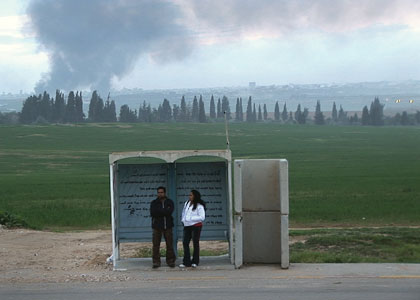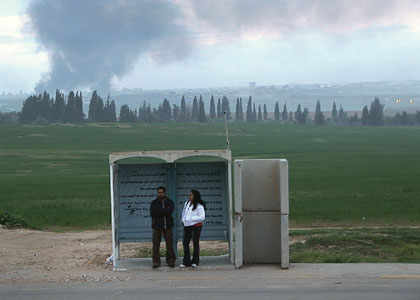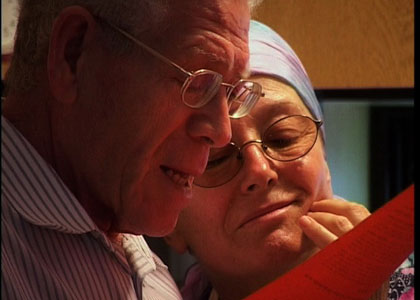Down Under
A Cinematic view of the South. Curators: Drorit Gur Arie, Maya Klein
22/07/2010 -
30/10/2010

The exhibition Down Under exposes life in Israel’s south, a “blind spot” for many of the country’s citizens and leaders. It turns a cinematic spotlight, the first of its kind on museum-scale, at an intricate reality in Israel’s periphery, a threatened space on the border between Gaza and Sderot.
It endeavors to prompt a discussion on Israeli society and its various shades, through a focused gaze at the fabric of life in the South, beyond that which is reflected in the news reports.
The exhibition features documentary films by established artists and by graduates of the Department of Cinema and Television at Sapir College.
The majority of these filmmakers live in the South and document the daily routine and human stories evolving in the shadow of the ongoing conflict and the various events over the years, from a personal, bittersweet perspective: from the story of Israeli and Palestinian fishermen who worked together before and after the Second Intifada in Avner Faingulernt and Macabit Abramson’s film Men on the Edge: A Fisherman’s Diary, through a view of the disengagement process from the point of view of a couple preparing for the evacuation of their home in Hadar Bashan’s In the Freimans’ Kitchen, to Robby Elmaliah’s film Hula & Nathan, unfolding the tragicomic story of two
brothers, auto-mechanics, who confront financial difficulties and an existential threat against the backdrop of the falling Qassam rockets.
The films are characterized by a cinematic language which blurs the boundary between fiction and documentary, combining crude realism with an air of poetry. The artists’ point of departure is underlain by observation of reality, unmediated contact with their surroundings and immediate human landscape, and an intimate, personal acquaintance with the featured characters throughout a prolonged filming process. The human dramas and the occurrences are revealed and clarified through the characters themselves, rather than through the artists’ structured narrative. It is a cinematic approach identified with the Department of Cinema and Television at Sapir College, which has, over the years, become an alternative cinematic center challenging the hegemonic narrative and representing a unique southern voice, one which had not been profoundly studied in Israeli cinema until the School’s founding.
The key work in the exhibition, Matador of War, a cinematic installation by Avner Faingulernt, Macabit Abramson, and Lev Goltser, presents a travel journal along the Gaza-Israel border during Operation Cast Lead edited in real time. It will premiere in the current exhibition. Based on a documentary film in progress, Matador of War will be shown in the Museum’s central space as a first-of-its-kind cinematic installation, a version created especially for the exhibition as part of a curatorial approach striving to introduce an experience which bridges the cinematic medium and art, creating an engaging dialogue between space, medium, and viewer.
The exhibition as a whole furnishes a unique viewing experience.
It offers a profound view and direct contact with the human landscape and the experience of life in the South, providing new insights into Israeli society.
Alongside the cinematic works, the exhibition will feature two video pieces about the South which introduce a different perspective on the documentary genre, and the documentary internet project Gaza-Sderot: Life in spite of it all which will be presented at interactive stations in the exhibition. The project included teams of Palestinians and Israelis which followed several figures from Sderot and Gaza for ten weeks. The short films have been broadcast on the Internet since the end of October 2008.
The exhibition is the result of a collaboration between the Petach Tikva Museum of Art, and the School of Cinema and Television at Sapir College,
a process that is intended to offer a museum platform to filmmakers living and working in the country’s southern area, and make for an internal view, from within the South itself, while presenting fresh perspectives and perceptions regarding the geopolitical space, center—periphery, and multiculturalism, as part of the agenda promoted by the Museum in the Israeli art field in recent years.
The Museum’s new cinema and media space “Spot” will be launched on opening night. The space is equipped with state-of-the-art technology.
It will serve as a platform for presentation of cinematic and digital media works in an attempt to expand the dialogue between various artistic mediums.




















